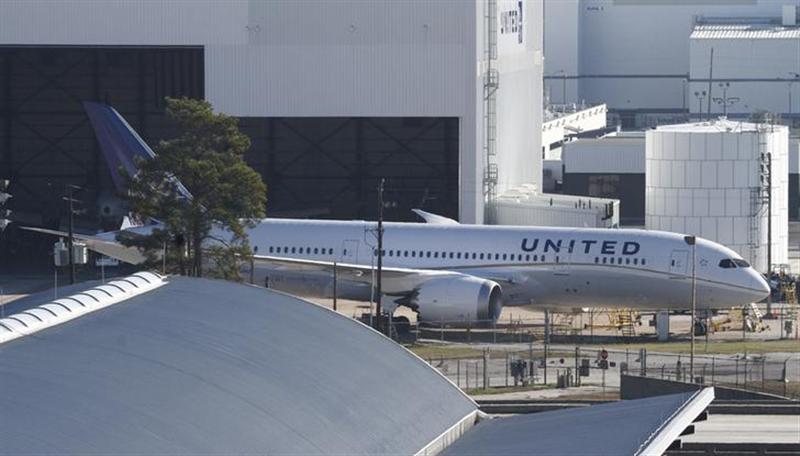United Airlines, the only U.S. operator of Boeing Co.’s 787 Dreamliner, is canceling flights by those planes almost four times as often as on the rest of its fleet, signaling that the new jets remain prone to breakdowns.
The carrier’s six Dreamliners had trips scrubbed 3.8 percent of the time from May 20 through June 26, according to Houston-based data tracker FlightAware.com, which reviewed the flights at the request of Bloomberg News. The rate excluding the 787s was 1 percent in the same period.
The data show the extent of disruptions at United since the 787s returned to service after a three-month global grounding to fix overheating batteries. While United isn’t discussing details of its cancellations, ANA Holdings Inc. and Japan Airlines Co. scrapped flights last month for reasons that included a computer failure, balky engine and trouble with an anti-icing system.
“When you go buy a new car, sometimes you’re back at the dealer a week later for a minor thing,” said George Hamlin, a former executive at planemaker Airbus SAS who now runs Hamlin Transportation Consulting in Fairfax, Virginia. “But if you have to keep going back week after week, it’s a problem.”
Dreamliners around the world were ordered parked in January after two battery meltdowns, the first such grounding in the U.S. for an entire model since 1979. Public interest in the jet remains so high that FlightAware offers a Web application for real-time monitoring of every 787 around the world.
‘Teething pains’
FlightAware compiled the flight figures from United’s data, which includes results such as the cancellations and delays displayed on airport monitors without detailing the causes.
United, a unit of United Continental Holdings Inc., is “very pleased” with the 787 even as the jet suffers “teething pains, like all new airplanes,” Chief Executive Officer Jeff Smisek told analysts at a Deutsche Bank AG conference last month. The 787 has the highest customer satisfaction scores of any plane in United’s fleet, he said.
“The 787 is going through a fine-tuning process,” said Mary Ryan, a United spokeswoman, likening the initial operational bumps to those experienced after Boeing unveiled the 777, its last all-new wide-body jet, in 1995.
“The 777 has turned out to be a highly reliable airplane,” she said by e-mail. “We see the 787 evolving into one as well.”
Emergency landings
A United 787 flying to Tokyo from Denver was forced to make an emergency landing in Seattle last month after an oil-filter warning, and another 787 flying to Denver from Houston had to turn around for an emergency landing because of what the Chicago-based airline said was a “brake-indicator issue.”
The Dreamliners also lagged behind the rest of United’s fleet in on-time performance, running late 30 percent of the time since May 20, with an average of 72 minutes, according to FlightAware. Flights by the rest of United’s planes were tardy 24 percent of the time, and those delays averaged 63 minutes.
The airline’s 787s are part of the first wave of the aircraft in service, as Boeing fills an order backlog for more than 800 of the first two Dreamliner variants and prepares to start work on a third.
Dreamliners are equipped with “advanced health monitoring features” that allow Boeing and airlines to understand in- flight events as they occur and prepare for maintenance needs before the plane lands, said Doug Alder, a Boeing spokesman.
“The 787 is a great airplane and we know it will continue to receive heightened attention when reliability events occur in service,” Alder said by e-mail. Chicago-based Boeing is focused on improving the 787’s reliability, he said.
ANA and Japan Airlines are the biggest operators of the plane, which was promoted to carriers as having a 20 percent increase in fuel economy over comparable twin-engine models.
Boeing’s use of composite-plastic construction helped focus attention on the 787 long before its commercial debut in 2011, and scrutiny from investors and customers grew even more intense when the first delivery ran 3 1/2 years late. Cancellations that are routine for other planes continue to draw notice because of that history.
“A certain amount of this is to be expected,” Hamlin said of the 787’s outsized rate for dropped flights. “New types have higher cancellation rates and squawks than existing types.”
With assistance from Julie Johnsson in Chicago. Editors: Ed Dufner, John Lear. To contact the reporter on this story: Mary Jane Credeur in Atlanta at mcredeur@bloomberg.net. To contact the editor responsible for this story: Ed Dufner at edufner@bloomberg.net.
Subscribe to Skift Pro to get unlimited access to stories like these
{{monthly_count}} of {{monthly_limit}} Free Stories Read
Subscribe NowAlready a member? Sign in here
Subscribe to Skift Pro to get unlimited access to stories like these
Your story count resets on {{monthly_reset}}
Already a member? Sign in here
Subscribe to Skift Pro to get unlimited access to stories like these
Already a member? Sign in here
